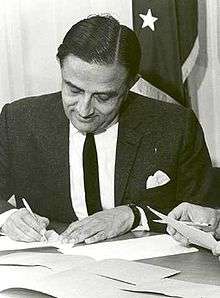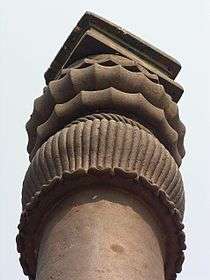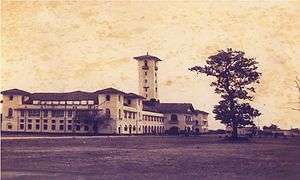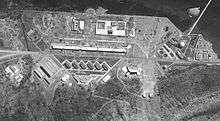Science and technology in India

After independence, Jawaharlal Nehru initiated reforms to promote higher education, science and technology in India.[2] The Indian Institute of Technology(IIT) – conceived by a 22-member committee of scholars and entrepreneurs in order to promote technical education – was inaugurated on 18 August 1951 at Kharagpur in West Bengal by the minister of education Maulana Abul Kalam Azad.[3] More IITs were soon opened in Bombay, Madras, Kanpur and Delhi as well in the late 1950s and early 1960s. Beginning in the 1960s, close ties with the Soviet Union enabled the Indian Space Research Organisation to rapidly develop the Indian space program and advance nuclear power in India even after the first nuclear test explosion by India on 18 May 1974 at Pokhran.
India accounts for about 10% of all expenditure on research and development in Asia and the number of scientific publications grew by 45% over the five years to 2007. However, according to former Indian science and technology minister Kapil Sibal, India is lagging in science and technology compared to developed countries.[4] India has only 140 researchers per 1,000,000 population, compared to 4,651 in the United States.[4] India invested US$3.7 billion in science and technology in 2002–2003.[5] For comparison, China invested about four times more than India, while the United States invested approximately 75 times more than India on science and technology.[5] The highest-ranked Indian university for engineering and technology in 2014 was the Indian Institute of Technology Bombay at number 16;[6] natural science ranks lower.[7] One study argued that Indian science did not suffer from lack of funds but from unethical practices, the urge to make illegal money, immense misuse of power, frivolous publications and patents, faulty promotion policies, victimisation for speaking against wrong or corrupt practices
While India has increased its output of scientific papers fourfold between 2000 and 2015 overtaking Russia and France in absolute number of papers per year, that rate has been exceeded by China and Brazil; Indian papers generate fewer cites than average, and relative to its population it has few scientists.[8] Based on the index of ISI indexed articles in India in 2017, it ranked 6th with 83,074 scientific papers, while this rating is far higher based on the number of articles per population.[9] According to StatNano's 2017 report, India's rank in this indicator in the field of nanotechnology is third in the world after China and USA, which points to its focus on this technology.[10]
History
 |
| History of science and technology in India |
|---|
| By subject |
1947–1967

India aimed "to convert India’s economy into that of a modern state and to fit her into the nuclear age and do it quickly." [2] It was understood that India had not been at the forefront of the Industrial Revolution, and hence made an effort to promote higher education, and science and technology in India.[2]
Planning Commission (1950) fixed investment levels, prescribed priorities, divided funds between agriculture and industry, and divided resources between the state and the federal governments.[2] The result of the efforts between 1947–1962 saw the area under irrigation increase by 45 million acres (180,000 km2), food production rise by 34 million metric tons, installed power generating capacity increase by 79 million kilowatts, and an overall increase of 94 percent in industrial production.[2] The enormous population rise, however, would balance the gains..[2] The economically beleaguered country was nevertheless able to build a large scientific workforce, second in numbers only to that of the United States and the Soviet Union.[2]
Education – provided by the government of India – was free and compulsory up to the Age of 14.[11] More emphasis was paid to the enhancement of vocational and technical skills.[11] J. P. Naik, member-secretary of the Indian Education Commission, commented on the educational policies of the time:[11]
The main justification for the larger outlay on educational reconstruction is the hypothesis that education is the most important single factor that leads to economic growth [based on] the development of science and technology.

On 18 August 1951 the minister of education Maulana Abul Kalam Azad, inaugurated the Indian Institute of Technology at Kharagpur in West Bengal.[3] Possibly modeled after the Massachusetts Institute of Technology these institutions were conceived by a 22-member committee of scholars and entrepreneurs under the chairmanship of N. R. Sarkar.[3]
The Sino-Indian war (1962) came as a rude awakening to military preparedness.[12] Military cooperation with the Soviet Union – partially aimed at developing advanced military technology – was pursued during subsequent years.[12] The Defence Research and Development Organisation was formed in 1958.
Radio broadcasting was initiated in 1927 but became state responsibility only in 1930.[13] In 1947 it was given the name All India Radio and since 1957 it has been called Akashvani.[13] Limited duration of television programming began in 1959, and complete broadcasting followed in 1965.[13]
The Indian Government acquired the EVS EM computers from the Soviet Union, which were used in large companies and research laboratories.[14]
1967–1987
The roots of nuclear power in India lie in early acquisition of nuclear reactor technology from a number of western countries, particularly the American support for the Tarapur Atomic Power Station and Canada's CANDU reactors.[15] The peaceful policies of Mohandas Karamchand Gandhi may have delayed the inception of nuclear technology in India.[15]
Stanley Wolpert (2008) describes the measures taken by the Indian government to increase agricultural output:[16]
The Indian space program received only financial support from the Soviet Union, which helped the Indian Space Research Organisation achieve aims such as establishing the Thumba Equatorial Rocket Launching Station, launching remote sensing satellites, developing India’s first satellite—Aryabhatta, and sending astronauts into space.[12] India sustained its nuclear program during the aftermath of Operation Smiling Buddha, the country's first nuclear tests.[12]
Though the roots of the Steel Authority of India Ltd. lie in Hindustan Steel Private Limited (1954), the events leading up to the formation of the modern avatar are described below:[17]
The Ministry of Steel and Mines drafted a policy statement to evolve a new model for managing industry. The policy statement was presented to the Parliament on December 2, 1972. On this basis the concept of creating a holding company to manage inputs and outputs under one umbrella was mooted. This led to the formation of Steel Authority of India Ltd. The company, incorporated on January 24, 1973 with an authorised capital of Rs. 2000 crore, was made responsible for managing five integrated steel plants at Bhilai, Bokaro, Durgapur, Rourkela and Burnpur, the Alloy Steel Plant and the Salem Steel Plant. In 1978 SAIL was restructured as an operating company.
In 1981, the Indian Antarctic Programme was started when the first Indian expedition was flagged off for Antarctica from Goa. More missions were subsequently sent each year to India's base Dakshin Gangotri.[18]
1987–present

Indian agriculture benefited from the developments made in the field of biotechnology, for which a separate department was created in 1986 under the Ministry of Science and Technology.[19] Both the Indian private sector and the government have invested in the medical and agricultural applications of biotechnology.[19] Massive biotech parks were established in India while the government provided tax deduction for research and development under biotechnological firms.[19]
The Indian economy underwent economic reforms in 1991, leading to a new era of globalisation and international economic integration.[20] Economic growth of over 6% annually was seen between 1993–2002.[20] Same year a new permanent Antarctic base Maitri was founded and continues to remain in operation till date.[18] On 25 June 2002 India and the European Union agreed to bilateral cooperation in the field of science and technology.[21] A joint EU-India group of scholars was formed on 23 November 2001 to further promote joint research and development.[21] India holds observer status at CERN while a joint India-EU Software Education and Development Centre is due at Bangalore.[21] Certain scientists and activists, such as MIT systems scientist VA Shiva Ayyadurai, blame caste for holding back innovation and scientific research in India, making it difficult to sustain progress while regressive social organisation prevails.[22] In addition, corruption and inefficiencies in the research sector and have resulted in corruption scandals and undermine innovation initiatives.[23]
Bangalore is considered to be the technological capital of India. IT, Biotechnology, Aerospace, Nuclear science, manufacturing technology, automobile engineering, chemical engineering, ship building, space science, electronics, computer science and other medical science related research and development are occurring on a large scale in the country. The southern part of India is responsible for the majority of technology and advancements the country has made. The golden triangle of IT and technology (Hyderabad, Bangalore and Chennai) forms the backbone of Indian manufacturing, R&D, science and technology.
In 2017, India became an associate member of European Organization for Nuclear Research.
Space exploration
Mars Orbit Mission
The Mars Orbiter Mission, also called "Mangalyaan",[24] was launched on 5 November 2013 by the Indian Space Research Organisation (ISRO).[25][26][27][28] It is India's first interplanetary mission,[29] making ISRO the fourth space agency to reach Mars, after the Soviet space program, NASA, and the European Space Agency,[30][31] the first Asian nation to reach Mars orbit, and the first nation to do so on its first attempt.[32][33][34][35]
Chandrayaan-1
On 18 November 2008, the Moon Impact probe was released from Chandrayaan-1 at a height of 100 km (62 mi). During its 25-minute descent, Chandra's Altitudinal Composition Explorer (CHACE) recorded evidence of water in 650 mass spectra readings gathered during this time.[36] On 24 September 2009 Science journal reported that the Chandrayaan-1 had detected water ice on the Moon.[37]
Thirty Meter Telescope
The Thirty Meter Telescope (TMT) is a planned, eighteen story, astronomical observatory and extremely large telescope to be built on the summit of Mauna Kea in the state of Hawaii. The TMT is designed for near-ultraviolet to mid-infrared (0.31 to 28 μm wavelengths) observations, featuring adaptive optics to assist in correcting image blur. The TMT will be at the highest altitude of all the proposed ELTs. The telescope has government-level support from several R&D spending nations: China, Japan, Canada and India.
Science academies in India
The idea of science academies in India has evolved along with the Indian independence movement. The three major science academies Indian National Science Academy, Indian Academy of Sciences and the National Academy of Sciences, India were all founded in the pre-independence era (pre-1947) between 1930 and 1935. The countries resulting from partition of the sub-content have subsequently founded their own academies, namely Pakistan which founded Pakistan Academy of Sciences in 1953 and later Bangladesh with the Bangladesh Academy of Sciences founded in 1973.
Indian Academy of Sciences
Also referred to colloquially as the "Bangalore Academy", Indian Academy of Sciences (IAS) was founded in 1934 by C. V. Raman, the eminent physicist of his time in Bangalore (now Bengaluru), Karnataka (formerly known as the State of Mysore), India.[38]
National Academy of Sciences, India
The founder and first president of the National Academy of Sciences, India (NASI) was Dr. Meghnad Saha in 1930 in Allahabad (Prayag), Uttar Pradesh, India.[39]
Indian National Science Academy
Founded in 1935 based on a proposal by the Indian Science Congress Association (ISCA) and National Institute of Science of India (NISI) with Dr. Meghnad Saha's blessings,[40] Indian National Science Academy (INSA) is based in New Delhi, India. According to its charter, the historical aim of the INSA was to be similar to the Royal Society, London, a gathering of learned people to exchange ideas and further science.
See also
Notes
- ↑ Burleson, D. (2008). Space Programs Outside the United States: All Exploration and Research Efforts, Country by Country. McFarland. 136. ISBN 0-7864-1852-4
- 1 2 3 4 5 6 7 Nanda 2006
- 1 2 3 Vrat 2006
- 1 2 "India lagging behind in S&Tt: Govt".
- 1 2 "India lagging in science and technology, says official". scidev.net. 29 August 2006.
- ↑ http://www.topuniversities.com/university-rankings-articles/asian-university-rankings/top-universities-asia-engineering-technology-2014
- ↑ http://www.topuniversities.com/university-rankings-articles/asian-university-rankings/top-universities-asia-natural-sciences-2014
- ↑ http://www.nature.com/news/india-by-the-numbers-1.17519
- ↑ "Nanotechnology in India | STATNANO". statnano.com. Retrieved 2018-06-25.
- ↑ "STATNANO ANNUAL REPORT". 2018-03-05. doi:10.22631/sar.2018.03.
- 1 2 3 Prabhu 2006
- 1 2 3 4 Khan 2006
- 1 2 3 Schwartzberg 2008
- ↑ Desai 2006
- 1 2 Raja 2006
- ↑ Wolpert 2008
- ↑ SAIL (2008). Background and History. Archived 7 April 2008 at the Wayback Machine.
- 1 2 "Maitri". 70south.com. Archived from the original on 6 October 2008. Retrieved 21 October 2008.
- 1 2 3 Sharma 2006, Biotechnology Revolution
- 1 2 Sharma 2006 Globalization
- 1 2 3 Ketkar 2006
- ↑ "Scientist blames caste for India's backwardness in research". Times of India. 25 July 2013. Retrieved 8 August 2013.
- ↑ Reddy, Prashant (20 May 2012). "CSIR Tech. Pvt. Ltd: Its controversial past and its uncertain future". SpicyIP.com. Retrieved 11 March 2013.
- ↑ "Mangalyaan". ISRO. NASA. 2013. Retrieved 27 September 2014.
- ↑ Walton, Zach (15 August 2012). "India Announces Mars Mission One Week After Landing". Web Pro News. Retrieved 8 September 2013.
- ↑ "Manmohan Singh formally announces India's Mars mission". The Hindu. 15 August 2012. Retrieved 31 August 2012.
- ↑ Bal, Hartosh Singh (30 August 2012). "BRICS in Space". New York Times. Retrieved 31 August 2012.
- ↑ Patairiya, Pawan Kumar (23 November 2013). "Why India Is Going to Mars". New York Times. Retrieved 23 November 2013.
- ↑ "India's Mars Shot". New York Times. 25 September 2014. Retrieved 27 September 2014.
- ↑ "India Launches Mars Orbiter Mission". Retrieved 6 November 2013.
- ↑ "India's low-cost space mission reaches Mars orbit". Retrieved 24 September 2014.
- ↑ "India's Mars satellite successfully enters orbit, bringing country into space elite". The Guardian. 24 September 2014. Retrieved 24 September 2014.
India has become the first nation to send a satellite into orbit around Mars on its first attempt, and the first Asian nation to do so.
- ↑ "India becomes first Asian nation to reach Mars orbit, joins elite global space club". The Washington Post. 24 September 2014. Retrieved 24 September 2014.
India became the first Asian nation to reach the Red Planet when its indigenously made unmanned spacecraft entered the orbit of Mars on Wednesday
- ↑ "India's spacecraft reaches Mars orbit ... and history". CNN. 24 September 2014. Retrieved 24 September 2014.
India's Mars Orbiter Mission successfully entered Mars' orbit Wednesday morning, becoming the first nation to arrive on its first attempt and the first Asian country to reach the Red Planet.
- ↑ Harris, Gardiner (24 September 2014). "On a Shoestring, India Sends Orbiter to Mars on Its First Try". New York Times. Retrieved 25 September 2014.
- ↑ http://www.planetary.org/blogs/emily-lakdawalla/2010/2430.html
- ↑ "Character and Spatial Distribution of OH/H2O on the Surface of the Moon Seen by M3 on Chandrayaan-1". Science Mag. 15 September 2009. Retrieved 26 September 2009.
- ↑ Home Page of the Indian Academy of Sciences
- ↑ Home Page of the National Academy of Sciences India
- ↑ Home Page of the Indian National Science Academy
References
- Alexander, Steve. E-Commerce. (2006: from Computers and Information Systems). Encyclopædia Britannica 2008.
- Desai, Ashok V. (2006). "Information and other Technology Development" in Encyclopedia of India (vol. 2), edited by Stanley Wolpert. 269–273. Thomson Gale: ISBN 0-684-31351-0.
- Ketkar, Prafulla (2006). "European Union, Relations with (Science and technology)" in Encyclopedia of India (vol. 2), edited by Stanley Wolpert. 48–51. Thomson Gale: ISBN 0-684-31351-0
- Khan, Sultanat Aisha (2006). "Russia, relations with" in Encyclopedia of India (vol. 3), edited by Stanley Wolpert. 419–422. Thomson Gale: ISBN 0-684-31352-9.
- Nanda, B. R. (2007). "Nehru, Jawaharlal" in Encyclopedia of India (vol. 3), edited by Stanley Wolpert. 222–227. Thomson Gale: ISBN 0-684-31352-9.
- Prabhu, Joseph (2006). "Institutions and Philosophies, Traditional and Modern" in Encyclopedia of India (vol. 2), edited by Stanley Wolpert. 23–27. Thomson Gale: ISBN 0-684-31351-0
- Raja, Rajendran (2006). "Nuclear weapons testing and development" in Encyclopedia of India (vol. 3), edited by Stanley Wolpert. 253–254. Thomson Gale: ISBN 0-684-31352-9.
- Sankar, U.(2007). The Economics of India's Space Programme, Oxford University Press, New Delhi. ISBN 978-0-19-568345-5.
- Sharma. Shalendra D.(2006). "Biotechnology Revolution" in Encyclopedia of India (vol. 1), edited by Stanley Wolpert. 154–157. Thomson Gale: ISBN 0-684-31350-2.
- Sharma, Shalendra D. (2006). "Globalization" in Encyclopedia of India (vol. 2), edited by Stanley Wolpert. 146–149. Thomson Gale: ISBN 0-684-31351-0
- Schwartzberg, Joseph E. (2008). India. Encyclopædia Britannica.
- Vrat, Prem (2006). "Indian Institutes of Technology" in Encyclopedia of India (vol. 2), edited by Stanley Wolpert. 229–231. Thomson Gale: ISBN 0-684-31351-0
- Wolpert, Stanley (2008). India. Encyclopædia Britannica.
External links
| Wikimedia Commons has media related to Science and technology in India. |
- India: Science and technology. U.S. Library of Congress.
- Indian National Science Academy (2001). Pursuit and promotion of science: The Indian Experience. Indian National Science Academy.
- Geek Nation: How Indian Science is Taking Over the World by Angela Saini (2011)
- Special report: Physics in India, Matin Durrani, Physics World, 2012.
- History of Science in South Asia (hssa-journal.org). HSSA is a peer-reviewed, open-access, online journal for the history of science in India.